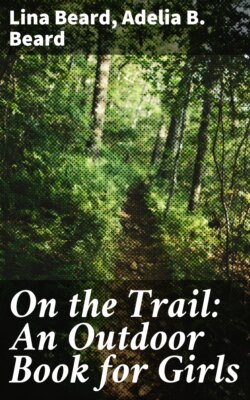Читать книгу On the Trail: An Outdoor Book for Girls - Adelia B. Beard - Страница 10
На сайте Литреса книга снята с продажи.
Lost in the Woods
ОглавлениеTable of Contents
We were in the wilderness of an Adirondack forest making camp for the day and wanted to see the beaver-dam which, we were told, was on the edge of a near-by lake. The guide was busy cooking dinner and we would not wait for his leisure, but leaving the rest of the party, we started off confidently, just two of us, down the perfectly plain trail. For a short distance there was a beaten path, then, suddenly, the trail came to an abrupt end. We looked this side and that. No trail, no appearance of there ever having been one. With a careless wave of his arm, the guide had said: "Keep in that direction." "That" being to the left, to the left we therefore turned and stormed our way through thicket and bramble, breaking branches as we went. Sliding down declivities, scrambling over fallen trees, dipping beneath low-hung branches, we finally came out upon the shore of the lake and found that we had struck the exact spot where the beaver-dam was located.
It was only a short distance from camp and it had not taken us long to make it, but when we turned back we warmly welcomed the sight of our blazed trail, for all else was strange and unfamiliar. Going there had been glimpses of the water now and then to guide us, returning we had no landmarks. Even my sense of direction, usually to be relied on and upon which I had been tempted to depend solely, seemed to play me false when we reached a place where our blazing was lost sight of. The twilight stillness of the great forest enveloped us; there was no sign of our camp, no sound of voices. A few steps to our left the ground fell away in a steep precipice which, in going, we had passed unnoticed and which, for the moment, seemed to obstruct our way. Then turning to the right we saw a streak of light through the trees that looked, at first, like water where we felt sure no water could be if we were on the right path; but we soon recognized this as smoke kept in a low cloud by the trees—the smoke of our camp-fire. That was our beacon, and we were soon on the trail again and back in camp. This is not told as an adventure, but to illustrate the fact that without a well-blazed trail it is easier to become lost in a strange forest than to find one's way.
You may strike the trail with the one object in view of reaching your destination as quickly as possible. This will help you to become agile and sure-footed, to cover long distances in a short time, but it will not allow of much observation until your mind has become alert and your eyes trained to see quickly the things of the forests and plains, and to read their signs correctly. Unless there is necessity for haste, it is better to take more time and look about you as you go. To hurry over the trail is to lose much that is of interest and to pass by unseeingly things of great beauty. When you are new to the trail and must hurry, you are intent only on what is just before you—usually the feet of your guide—or if you raise your eyes to glance ahead, you notice objects simply as things to be reached and passed as quickly as possible. Unhurried trailing will repay you by showing you what the world of the wild contains.
Walking slowly you can realize the solemn stillness of the forest, can take in the effect of the gray light which enfolds all things like a veil of mystery. You can stop to examine the tiny-leafed, creeping vines that cover the ground like moss and the structure of the soft mosses with fronds like ferns. You can catch the jewel-like gleam of the wood flowers. You can breathe deeply and rejoice in the perfume of the balsam and pine. You can rest at intervals and wait quietly for evidences of the animal life that you know is lurking, unseen, all around you; and you can begin to perceive the protecting spirit of the wild that hovers over all.
To walk securely, as the woodsmen walk, without tripping, stumbling, or slipping, use the woodsmen's method of planting the entire foot on the ground, with toes straight ahead, not turned out. If you put your heel down first, while crossing on a slippery log as in ordinary walking, the natural result will be a fall. With your entire foot as a base upon which to rest, the body is more easily balanced and the foot less likely to slip. When people slip and fall on the ice, it is because the edge of the heel strikes the ice first and slides. The whole foot on the ice would not slip in the same way, and very often not at all.
Trailing does not consist merely in walking along a path or in making one for yourself. It has a larger meaning than that and embraces various lines of outdoor life, while it always presupposes movement of some kind. In one sense going on the trail means going on the hunt. You may go on the trail for birds, for animals, for insects, plants, or flowers. You may trail a party of friends ahead of you, or follow a deer to its drinking-place; and in all these cases you must look for the signs of that which you seek.
